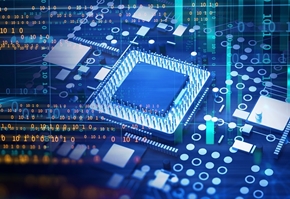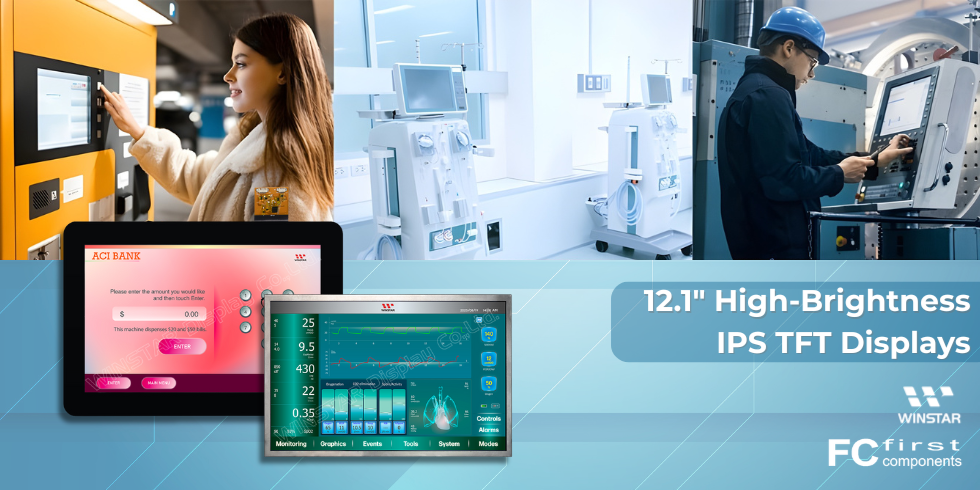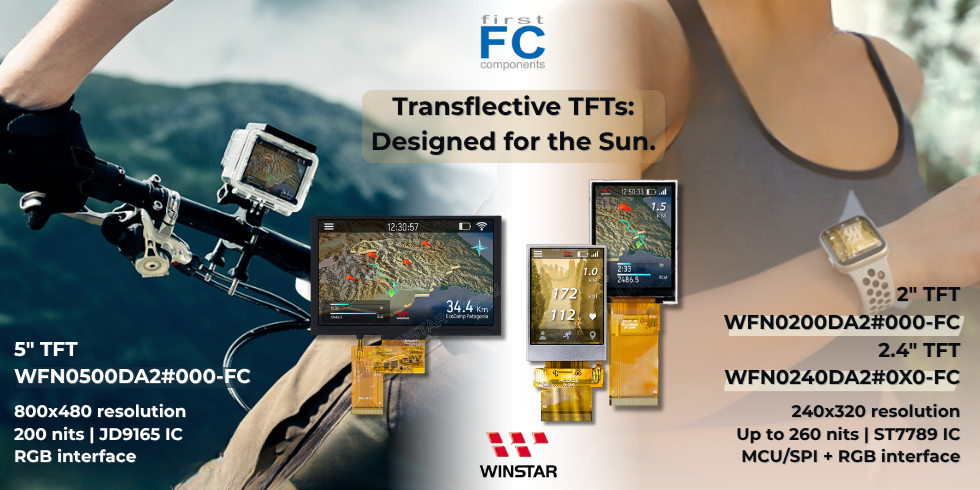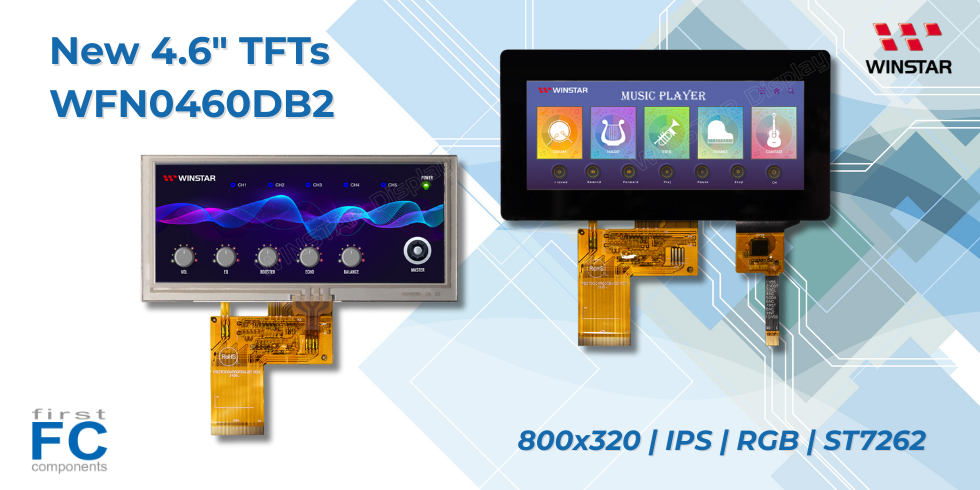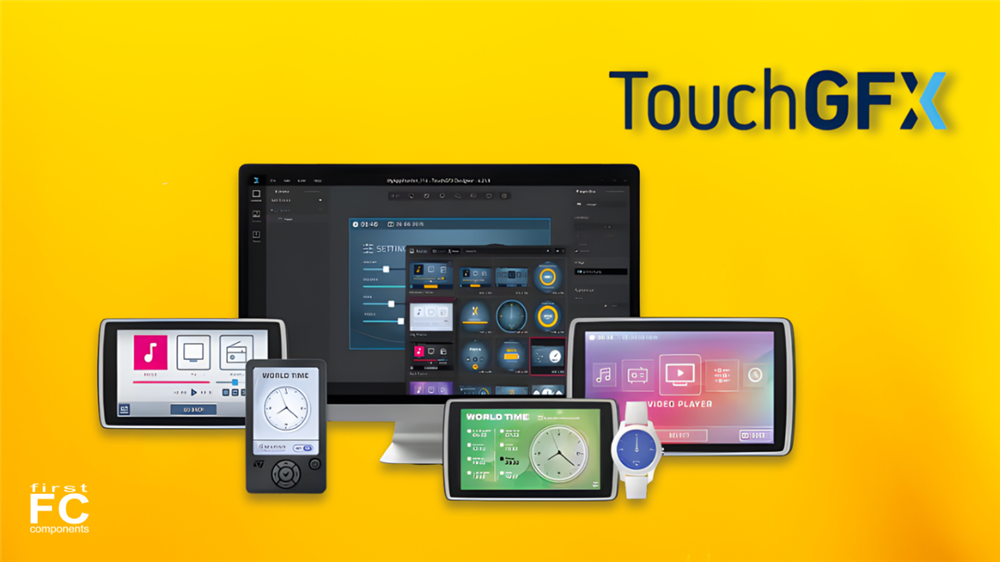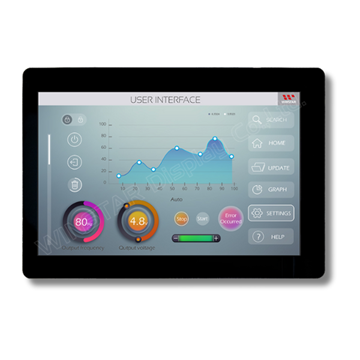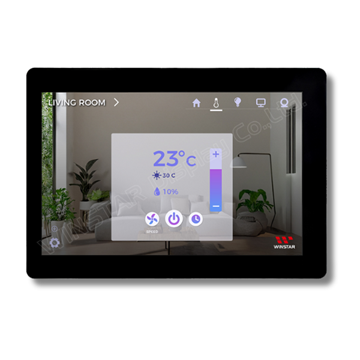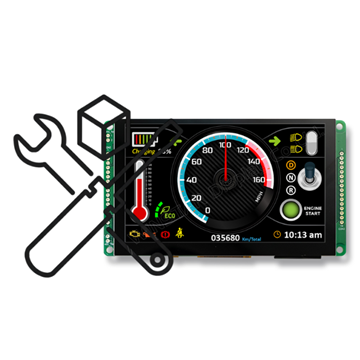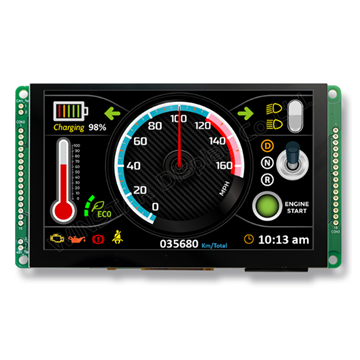- Register
- Log in
-
Shopping cart
(0)
You have no items in your shopping cart.
FIRST Components Academy | Next-gen graphic interfaces with TouchGFX
Efficient Graphical Interfaces with STM32 Microcontrollers and TouchGFX
Next-generation graphical interfaces are no longer exclusive to complex systems or processor-based platforms: today, even microcontrollers can deliver sophisticated, smooth, and visually appealing user experiences. The evolution of HMI (Human-Machine Interface) design has driven increasing demand for solutions that combine performance, energy efficiency, and flexibility—without compromising cost control.
Within this context, the STM32 ecosystem by STMicroelectronics stands out, combining the power and scalability of its extensive microcontroller portfolio with the TouchGFX graphical environment: a complete framework for creating professional GUIs with a low-footprint approach optimized for embedded systems. The tight integration between hardware and software reduces development complexity, accelerates time-to-market, and ensures visual quality comparable to that of consumer devices.
An Ecosystem Designed for Embedded Graphics
The STM32 ecosystem offers a complete portfolio of scalable MCUs in terms of processing power, memory, and energy consumption. Each family is designed to achieve a specific balance between graphical performance, energy efficiency, and total system cost. Thanks to the ARM® Cortex® architecture and native TouchGFX support, STM32 MCUs enable GUI development on a single chip or hybrid architectures with external memory, while maintaining fine control over resources and responsiveness.
The key advantage is design continuity: the same development environment, tools, and codebase can be seamlessly transferred from an entry-level platform such as STM32G0 to a higher-performance one like STM32H7 or STM32H5, by simply adjusting memory and display parameters. This modular approach allows designers to start small and scale as the project evolves or as higher performance becomes necessary.
For developers, the STM32 ecosystem offers:
• architectures optimized for embedded graphics with dedicated accelerators;
• ample RAM and Flash availability with partial or full framebuffer support;
• direct integration with TouchGFX and STM32CubeIDE / STM32CubeMX tools
• a consistent and interconnected software ecosystem, with preconfigured graphics libraries and comprehensive documentation.
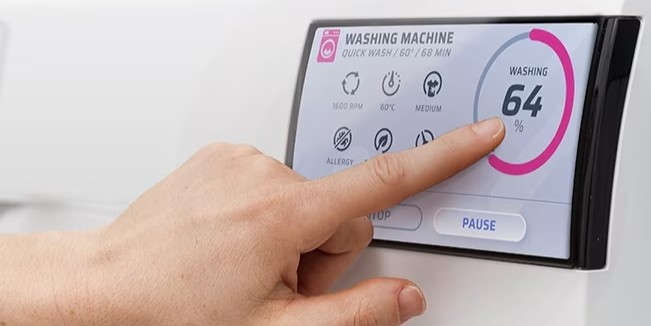
Graphics Accelerators: The Core of the STM32 Pipeline
A key differentiator of the STM32 platform is the presence of integrated hardware accelerators that enable high graphical performance without burdening the CPU, drastically reducing power consumption and improving interface responsiveness.
• Chrom-ART™ Accelerator (DMA2D): manages bit-blitting, alpha-blending, area filling, and color format conversion, offloading the CPU from frequent
graphic operations. The result is faster rendering, smoother transitions, and lower bus load with reduced power usage.
• NeoChrom GPU e NeoChrom VG (Vector Graphics): available on MCUs such as STM32H7R7 and STM32U599, they provide true 2D and 2.5D graphic
engines capable of handling vector drawing, rotations, anti-aliasing, shading, and complex font rendering. These GPUs deliver rich, dynamic GUIs
while maintaining a low-power approach and minimal CPU load.
• JPEG hardware codec: accelerates image and MJPEG video decoding/compression, allowing multimedia content management without compromising
overall performance.
• Chrom-GRC™: an optional module for complex and analytical graphic processing, designed for applications where visual analysis or pattern recognition
integrates with the GUI.
Beyond accelerators, STM32 MCUs ensure fast, direct access to internal and external memories, avoiding bottlenecks during frame transfers. This architecture guarantees smooth animations—even with partial buffers—and excellent energy efficiency, especially in portable applications.
Memory, Display Interfaces, and Framebuffer Strategies
Efficient graphical design requires a careful balance of memory resources, display interfaces, and hardware accelerators. Single-chip solutions with internal framebuffers are ideal for small displays (up to QVGA or WQVGA), where the integrated SRAM is sufficient for graphical buffering. For larger or more complex displays, STM32 MCUs can interface with external memories (SDRAM, QSPI, OSPI) to enable double buffering, caching, and more advanced graphical pipelines. The combination of DMA2D, LTDC (LCD-TFT Display Controller), and external bus access ensures continuous data flow and responsive GUIs even with dynamic content.
Supported display interfaces include RGB-TFT and MIPI-DSI for medium to large high-resolution displays, and Parallel 8080/6800 and SPI for compact, low-cost screens. This variety allows designers to choose the best trade-off between performance, cost, and project complexity.
STM32 Microcontroller Families for Graphical Applications
The STM32 platform covers a wide range of needs—from ultra-low-power designs to high-end graphical interfaces. Each family offers a distinct mix of frequency, memory, and integrated graphic peripherals:
| MCU Family | Core | Frequency | RAM / Flash | Key Features | Typical GUI Applications |
| STM32C0 / G0 | Cortex-M0+ | up to 64 MHz | up to 144 KB RAM / 512 KB Flash | Low-cost, energy efficient, compact GUIs with partial framebuffer | 2.4"–3.5" displays, industrial controls, simple panels |
| STM32U0 / U3 | Cortex-M0+ / M33 | up to 96 MHz | up to 256 KB RAM / 1 MB Flash | Ultra-low-power, battery-powered, TouchGFX compatible | Portable instruments, sensor HMIs |
| STM32U5 (U585 / U599) | Cortex-M33 | up to 160 MHz | up to 786 KB RAM / 2 MB Flash | Large internal SRAM for framebuffer, integrated NeoChrom GPU, TrustZone security | Advanced low-power GUIs, medical and wearable devices |
| STM32F7 | Cortex-M7 | up to 216 MHz | up to 512 KB RAM / 2 MB Flash | Integrated LTDC, external SDRAM bus, cost-performance balance | Industrial/medical HMI, interactive panels |
| STM32H5 / H7 | Cortex-M33 / M7 | up to 480 MHz | up to 1 MB RAM / 2 MB Flash | High-performance graphics, Chrom-ART™, optional GPU, advanced security | High-resolution displays, infotainment, automation |
| STM32WB / WBA | Cortex-M4 / M33 | up to 100 MHz | up to 512 KB RAM / 2 MB Flash | Integrated wireless (BLE / Thread / Zigbee), low-power optimized graphics | IoT terminals, connected panels, remote systems |
| STM32N6 | Cortex-M55 | up to 800 MHz | 4.2 MB internal SRAM / external Flash (XSPI, FMC) | NeoChrom GPU, Chrom-ART™, Chrom-GRC, LTDC controller, high memory bandwidth, AI options (Neural-ART) | Advanced industrial HMI, complex/multimedia GUIs, edge AI + graphics |
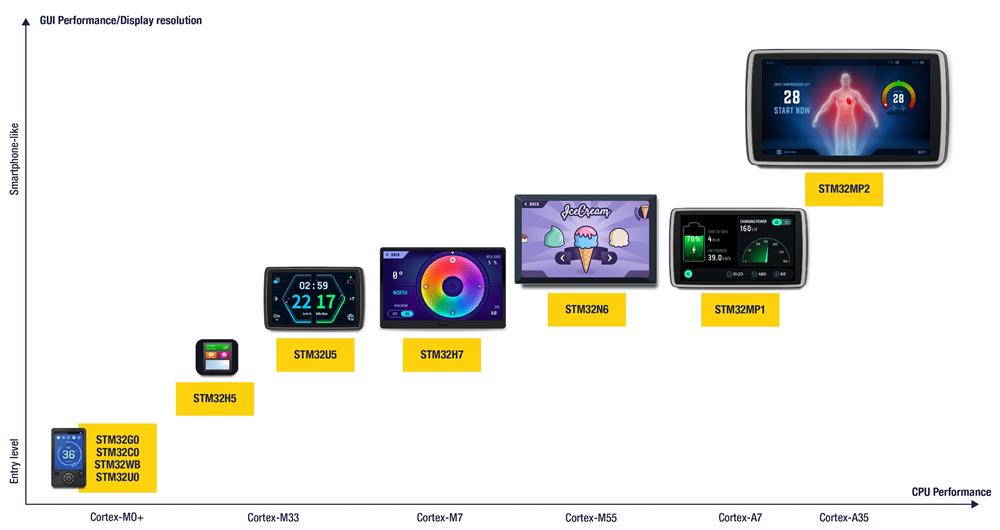
The ability to combine different families and peripherals allows designers to scale projects while maintaining software compatibility and the same development logic.
The TouchGFX Environment: From Design to Simulation
TouchGFX is the core of graphical development on STM32. It is a free, complete environment fully integrated with STM32CubeIDE, simplifying every phase of GUI design—from layout definition to event programming.
1. TouchGFX Designer, a visual tool to create and simulate GUIs on PC, managing widgets, transitions, and graphic resources.
2. TouchGFX Generator, to generate STM32 source code directly from the graphical project.
3. TouchGFX Engine, an optimized runtime library leveraging STM32 hardware accelerators to maximize interface smoothness.
The result is an integrated, intuitive, and highly efficient environment that shortens development cycles and allows GUI validation directly on hardware.
Intelligent Displays with Integrated STM32 MCUs
FIRST Components’ Intelligent Displays come standard with STM32F7 and STM32H7 microcontrollers, offering a ready-to-use platform for embedded GUI development. Each module combines a high-visibility TFT display, optimized memory architectures (full or partial framebuffer), and standard interfaces such as UART, RS-485, and CAN Bus.
Development kits and software demos are also available, allowing rapid evaluation of graphical performance and compatibility with target systems.
 |
 |
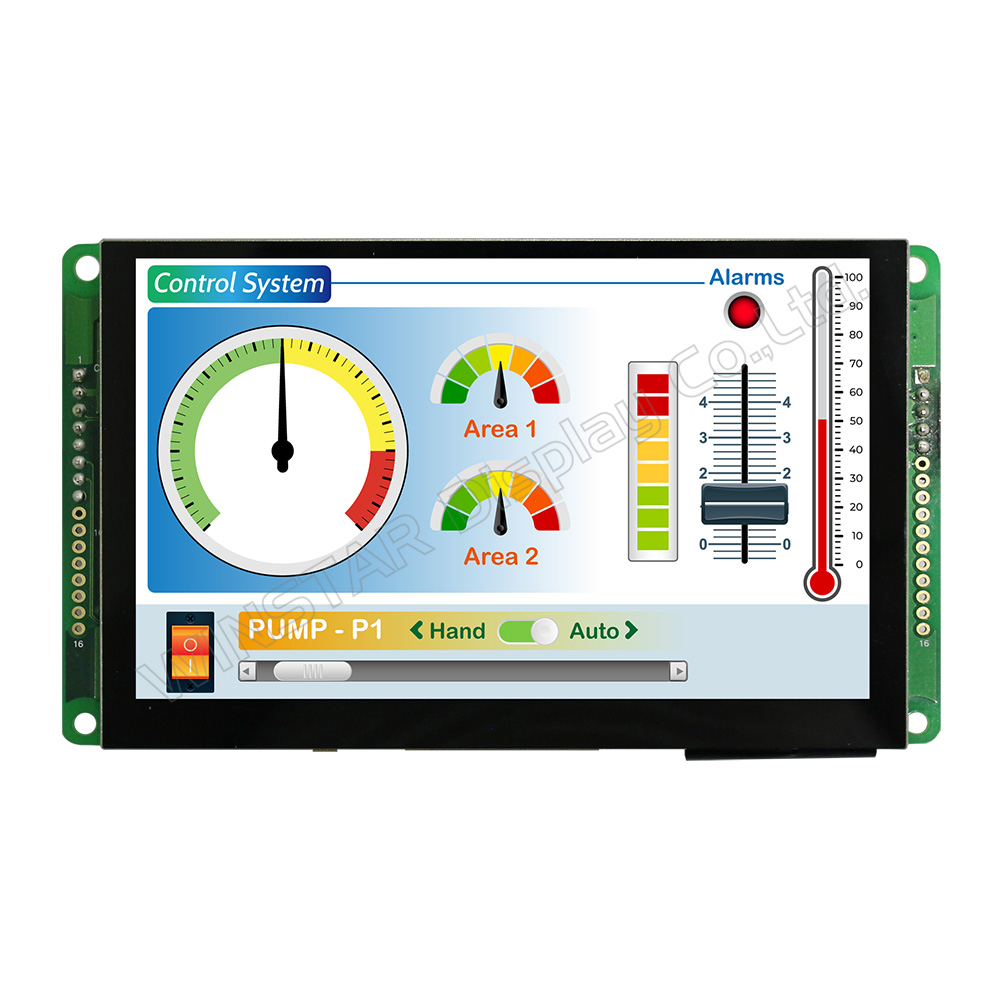 |
| UART Interface | RS485 Interface | CAN BUS Interface |
These solutions let developers focus on interface design and application logic, leveraging STM32 hardware reliability and the flexibility of the TouchGFX framework.
Customizable and Scalable Solutions
For projects with specific requirements, custom versions of the Intelligent Display are available, allowing selection of the most suitable STM32 MCU (F4, F7, H7, U5, H5, WB, etc.) and customization of:
• display size, resolution, and technology;
• communication interfaces;
• memory architecture and buffering strategy.
This approach enables tailor-made GUIs while maintaining full compatibility with the STM32 ecosystem and the TouchGFX suite.
Design and Application Benefits
• Simplified graphic development and intuitive UI update management
• Reduced NRE costs and faster release cycles, thanks to unified tools and optimized libraries
• Smooth, modern user experiences even on low-power MCUs
• Industrial and medical-grade reliability with deterministic and robust pipelines
• Scalability and code reuse across multiple STM32 MCU families, reducing project risk
Conclusion
Using STM32 microcontrollers as the foundation for graphical interfaces represents one of the most efficient and versatile solutions in the embedded market today. The combination of STM32 with TouchGFX and STM32-based Intelligent Displays enables the creation of high-performance, visually refined GUIs ready for production—without the need for complex or costly hardware. From entry-level prototyping to advanced HMI production, STMicroelectronics provides a complete ecosystem of tools, documentation, and technical support to bring next-generation graphical interfaces to market.
Additional Resources
TouchGFX Documentation and Resources
"How to TouchGFX" - Video Tutorial



